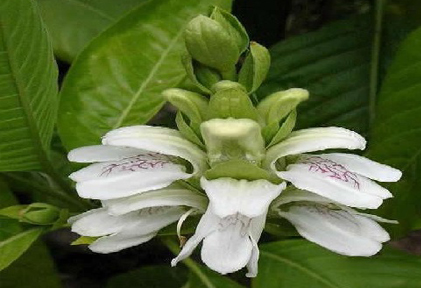
Adhatoda vasica (L.)
This is an evergreen shrub with large lanceolate leaves. Flowers are in dense, short spikes. Colour of the flower is white with few purplish marking. Fruits are capsular.
Chem.: Vasicine
Action/ Uses: Leaf, flower, stem: In the treatment of body inflammation and body ache. The leaf decoration is used for cough and chronic bronchitis.
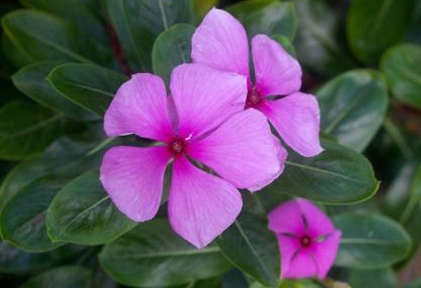
Catharanthus roseus (L.)
Perennial under shrubs, about 24cm tall, with cinnamon brown colour barks. Leaves are 6.5 x 2.3cm, glabrous. Flowers are white, rosy and may other, solitary or geminate, axillary. Follicles 1.3-4.4cm long, paired, narrowly linear, longitudinally ribbed, shortly beaked. Seeds are black, cylindric, ribbed. Flg. and Frg.: Throughout the year.
Chem.: Root- Taubasin, serpentine; leaves- vincristine and leukemia.
Action/Uses: Panchang: Useful in diabetes, wasp-stings, menorrhagia and
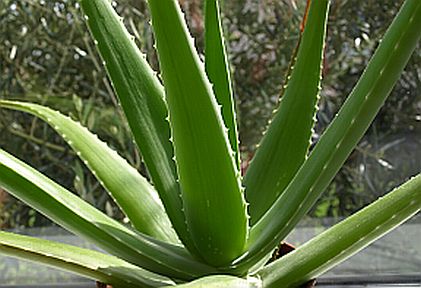
Aloe barbadensis Mill
Acaulescent shrub. Leaves 22 x 6.7cm, in rosette, lanceolate or ensiform, spinous-toothed on margins. Flowers 1.5-1.9cm long, arranged in about 43cm long racemes, on upper part of 32-71cm long scape. Fruit 1.45 x 0.5-0.9cm, trigonous-oblong, loculicidally 3 valve. Seedstrigonous, winged. Flg.: Dec-April Frg.: Jan-May.
Chem.: Aloin, Aloe gel.
Action/ Uses: Leaf: In eye affection & internally in lilies, cough and as an external application to inflamed & painful part of the body.
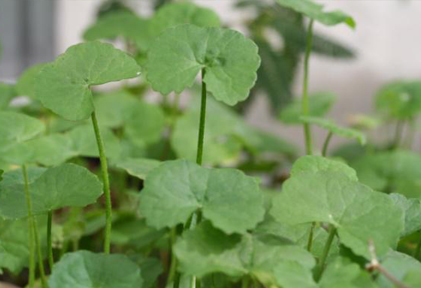
Centella asiatica (L.)
Radically creeping, about 36cn long herbs. Leaves are 2-3.2cm in diameter, broadly sub-orbicular to reniform, glabrous. Flowers are small pink or red, in axillary, fasciculate umbels. Fruit 0.4-0.5cm long, ovoid, articulately wrinkled, primary and secondary ridges distinct. Flg. and Frg.: Throughout the year.
Chem.: Asiaticoside, brahmoside, vitamin C.
Action/ Uses: Panchang: In skin diseases, as tonic, insomnia, cardiac debility, asthama, bronchitis, hiccough, abdominal disorders and fevers.
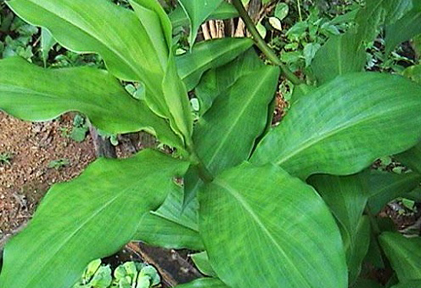
Insulin Plant
Botanical Name: Costus Igneus
Family: Costaceae
Actions: Anti-Diabetic
“A medicinal plant with Anti-diabetes property”
Insulin Plant Medicinal Uses:
The leaves of this herbal medicinal plant are used to control Blood sugar levels or in Treatment of Diabetes. The patient has to consume two leaves in the morning and two leaves in evening for first week. From the second week one leaf in the morning and one in the evening. This dosage should be continued for 30 days. The leaves of Insulin plant must be chewed well before swallowing. After chewing the leaves / leaf have a little water.
Having natural concentration of Corosolic acid, Insulin plant can have a positive effect on blood sugar levels. Corosolic acid works in metabolism of glucoseprocess like insulin that reduces blood sugar levels by transporting glucose into cells and out of the bloodstream. This can be beneficial to anyone who has trouble with high blood sugar levels, and particularly to that in diabetes
In Indian Traditional Medicine this herbal plant is also used to promote Long life, Take care of skin complaint, Reduce fever, Treatment of asthma, Bronchitis treatment and to Eliminates intestinal worms. In Indian traditional literature this plant is mentioned as an ingredient in a cosmetic to be used on the eyelashes to give a nice look.
Name in other languages of the Insulin plant:
Bengali – Piasal
Hindi- Banda, Bija-sal, Peisar , JARUL, Keukand
Kannada – Kempu honne
Malayalam – Honne, Karintakara, Vengai, Venna-maram
Marathi – Honi , Pushkarmula
Odisha – Vengis
Sanskrit – Asana, Bandhukapushpa
Tamil – Neyccarikamaram,Venkai-c-ciray,Kostam
Telugu – Peddavesiga, Yeangesha
Urdu- Bijasar, Dam al akhwain
Gujarati – Pakarmula
English – Banaba
This leaf is not recommended for pregnant or lactating women
Ref.: www.happylifestyletips.com
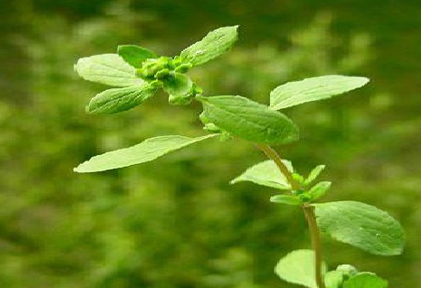
Marva
Botanical Name:- Origanum majorana
Marjoram (Origanum majorana)is an aromatic herb in the mint family which originated in Egypt and Arabia. It is also widely referred to as Oregano. Today, it is commonly found in the Mediterranean region or grown in gardens around the world. In its varied forms of: Marjoram essential oil, fresh or dried Marjoram leaves, or Marjoram powder (ground up Marjoram), it has many uses. As a culinary additive, it is commonly used to flavor soups, sauces, salads, and meat dishes. Cosmetically, Marjoram is used in skin cream, body lotion, shaving gel, and bath soaps. Whether used as an essential oil, powder, fresh leaves, or dried leaves, Marjoram has many uses with numerous health benefits. Marjoram (Origanum majorana)synonyms are: Majorana hortensis Moench, Majorana was alleged created by Aphrodite as a symbol of happiness! Also known as sweet or knotted marjoram. Sweet pine and citrus flavoured grey green foliage. A very valuable herb as an infusion as it is a relief for stomach pains. A member of the mint family. Recommended by the RHS to be an excellent attractant and nectar source for bees and other beneficial insects. Tender perennial. Reaches 2 feet (60 cm) tall. Likes a warm sunny position. Likes dry, rocky, free draining soil. Suitable for container growing. Flowers July – September with small pale pink flowers. If you cut plants to 1″ (2.5 cm) in Autumn they can be brought indoors.
Culinary Uses :
- Good for use in stews, soup, on pizza, with pasta, eggs and cheese!
- Can be infused for tea.
- Chopped into salad.
- Can be used in bouquet garni.
- Good compliment for fish.
- Flowers are edible.
- Medicinal Uses.
- Can ease tonsilitus.
- Can help flatulence.
- Can ease stomach bloating.
- Can help sleep or calm children.
- Can ease anxiety.
- Homeopaths sometimes use to treat female sex disorders and painful menstruation.
- Good for bruises.
- Has good antiseptic properties.
- Used to make essential oils.
Other Uses :
- As nosegays!
- Used in pot pourri and herb pillows.
- Has been used to scent furniture polish.
Disclaimer :
As with all alternative medicines and plants with purported medicinal benefits it is important to inform your health care providers that you are using them; this helps to ensure safe and coordinated care. We can accept no liability for any side effect or contingency from any allergy or any other cause or harm that may arise. If in doubt please do consult a medical practitioner before using.
Do not use if pregnant.
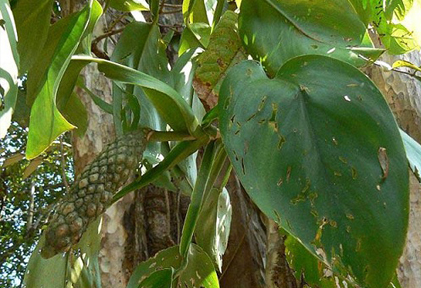
Gajapimpali
Family: Araceae
Genus: Scindapsus
Botanical name: Scindapsus officinalis
PLANT NAME IN DIFFERENT LANGUAGES
Sanskrit: Hastitippali, Gajapippali
Hindi: Gajapippal, Baripippli
English: Gajapippali
Malayalam: Atitippali, Aanatippali, Gajatippali
MEDICINAL PROPERTIES
Gajapippali is large epiphytic climber, up to 25 cm long. Stems are thick as the little finger and branches are wrinkled when dry. Leaves are 12.5-25.0 x 6.0-15.0 cm, ovate or orbicular, caudate acuminate and dark green with rounded or slightly cordate base. Peduncles are solitary and terminal. Spathe is 10-15 cm long, subcylindrical and spadix is elongated in fruits and greenish yellow. Berries, its fruits are few and fleshy. Seeds are ovate-cordate. Flowering and fruiting is almost throughout the year.
In ayurveda its fruits are descrided as anthelmintic, appetizer, aphrodisiac, galactagogue and pungent, these are used in asthma, dysentery and problems of throat.
Copyright © 2019 Alpha Agro & Landscape Services. All Rights Reserved.
